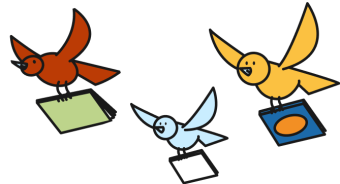
A realistic illustration and the titular question and a couple of hints ask readers to guess what came from the pictured egg. A page turn reveals the animal along with brief information about them. “Eggcellent” facts are included.
Whose Egg Is That?

Lift an acorn to discover a squirrel peeking out of a hole and more. Small hands will delight in the crinkling noise when soft flaps are lifted to see what forest surprise is hidden beneath. Find more surprises in this companion book about ocean inhabitants, Peekaboo Ocean (opens in a new window).
Peekaboo Forest

What do hands do? They greet, touch, hush, heal, and ever so much more. Simple black and while line illustrations use touches of color and single words in a cozy size for the very young, sure to grow with children and inspire myriad discussions.
My Hands

With a growing global population, we will need more and more space to live, learn and work in. But what does that mean for the health of the planet? Can we do it sustainably? Tall buildings may be part of the answer. From the Great Pyramids of Giza and the Leaning Tower of Pisa to the Burj Khalifa and the Shanghai Tower, this book asks why and how we build higher and higher, and what that means for the planet.
Why Humans Build Up: The Rise of Towers, Temples and Skyscrapers

How do our leaders, from local mayors on up to Presidents and Supreme Court Justices, go about getting their jobs, and just what are their jobs? Learn what every good citizen needs to know about American democracy in action, and how our basic system of “government of the people, by the people, and for the people” remains the same.
The Voice of the People: American Democracy in Action

An A-Z trip through our government’s structure, from its earliest beginnings to definitions of basic components and concepts (including immigration and taxation). From founding fathers, first ladies, and the First Amendment to the presidential oath of office, D is for Democracy details the political processes, parties, and people of democracy, American-style.
D Is for Democracy: A Citizen’s Alphabet

Told in the words of a child, this picture book shows how an Indian family prepares for the festival of Diwali. Young and old participate equally in these preparations. Everyone helps clean the house and decorate it with buntings and vibrant, colorful art. Traditional foods and sweets are made, and new clothes are bought. When Diwali begins, families come together to worship, sing hymns, and tell stories of gods. It’s time to visit friends and neighbors. Fireworks brighten the skies, and gifts are exchanged. (School Library Journal)
Shubh Diwali!

This board book features photographs of adorable babies and toddlers experiencing the Diwali holiday in wide-eyed wonder, surrounded by the gentle love and affirmation of adults. The text does an excellent job balancing universal experiences with culturally specific ones. The book presents an age-appropriate view of the holiday from morning until night. (School Library Journal)
Diwali Lights
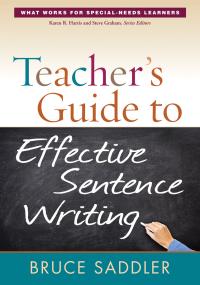
This practical book provides explicit instructions for teaching sentence-level skills to students who have difficulties in this area. The author explains the key role of sentence combining in the writing process and presents effective techniques for instruction and assessment. Numerous sample lessons, practice activities, planning tips, and grammatical pointers make it easy for teachers to incorporate sentence combining and construction into the writing curriculum at all grade levels (2-12).
Teachers Guide to Effective Sentence Writing

Beautiful, joy-filled, color photographs of children studying, learning, exploring, and having fun invites young readers to see other kids just like them from all over the world. Whether they take a school bus, a boat, or a rickshaw to get there, kids around the globe are going to school and growing smarter and more curious every day.
Back to School: A Global Journey

Journey back in time and around the world to learn about dozens of dinosaurs in this colorfully illustrated atlas for very young children.
My First Dinosaur Atlas: Roar Around the World with the Mightiest Beasts Ever!

As a young student, Mayor wondered: Is the mythical griffin based on ancient people’s interpretations of dinosaur bones? This biography shares her fascinating efforts to prove her theory correct and reveals other connections between science and human myth as well. (School Library Journal)
The Griffin and the Dinosaur: How Adrienne Mayor Discovered a Fascinating Link Between Myth and Science

With engaging text, photographs, and vivid paleoart, this biography introduces Mary Anning, the Victorian fossil hunter and self-taught scientist who changed scientific thinking about prehistoric life and would become one of the most celebrated paleontologists of all time. Mary Anning grew up on the south coast of England in a region rich in fossils. As teenagers, she and her brother Joseph discovered England’s first complete ichthyosaur. Poor and uneducated, Anning would become one of the most celebrated paleontologists ever, though in her time she supported herself selling by fossils and received little formal recognition.
Fossil Hunter: How Mary Anning Changed the Science of Prehistoric Life

Think you know about dinosaurs? Think again! Paleontologist Steve Brusatte brings young scientists and readers everywhere into his world of massive herbivores and fearsome predators, daily unexpected discoveries, and all the new science used to learn about some of the world’s oldest beings.
The Age of Dinosaurs: The Rise and Fall of the World’s Most Remarkable Animals

Showcasing more than 90 remarkable fossils, such as a Tyrannosaurus skull, delicate fern leaf, and perfectly preserved woolly mammoth, each plant or animal featured is shown both photographically and illustrated, and children will love poring over the detailed close-up images. The storybook descriptions let you discover the myths and legends surrounding the organisms, as well as key facts about their natural history. Find out why Pachycephalosaurus had such a thick head, how a coral fossil can be used to work out how long a prehistoric year was, and which fossil was thought to protect people from poison.
Dinosaurs and Other Prehistoric Life

Through infographics, illustrations, facts, and figures, readers will learn about the giants that roamed the earth millions of years ago, but that still captivate their imaginations: Dinosaurs. Discover some of the most fascinating aspects of dinosaurs through astonishing numbers: the varying sizes and shapes of dinosaurs, timelines of when they roamed the earth, charts comparing the fastest dinos with the speedy animals of today, maps of where these giant reptiles lived across the globe, and so much more.
Dinosaurs: By the Numbers

Young dinosaur lovers are introduced to an amazing range of prehistoric beasts through facts and detailed illustrations. Discover how the Earth has changed over time, why fossils formed, and the arrival of early humans. A pronunciation guide helps kids with tricky names and encourages early learning and language development. The helpful visual index provides a quick overview of every species in the book.
My Book of Dinosaurs and Prehistoric Life: Animals and Plants to Amaze, Surprise, and Astonish!

Through rhyming text, learn about the evolutionary link between million-year-old dinosaurs and modern-day birds.
Dinosaur Feathers

This book introduces young readers to all key science and facts about dinosaurs in a fun question and answer format. The book’s wide-ranging Q&As include: How did dinosaurs become fossils? What happens at a dinosaur dig? Who invented the word “dinosaur”? Were dinosaurs striped and feathery? Which dinosaur’s bite was the most powerful? Did dino poops become fossils? What sounds did dinosaurs make? Did dinosaurs build nests? And what happened to the dinosaurs?
My First Big Book of Dinosaur Facts
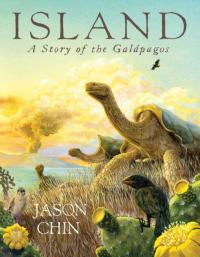
Young readers will explore the evolving terrain and animals of the Galápagos in this nonfiction picture book. Charles Darwin first visited the Galápagos Islands almost 200 years ago, only to discover a land filled with plants and animals that could not be found anywhere else on earth. How did they come to inhabit the island? How long will they remain? Thoroughly researched and filled with intricate and beautiful paintings by award-winning author and artist Jason Chin.
Island: A Story of the Galápagos
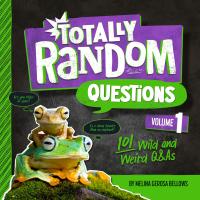
Ever wondered what the planet Mercury is made of or why cats purr? This first in a new series asks and answers 101 questions sure to intrigue and inspire further research, each presented with color photographs and a varied format.
Totally Random Questions Volume 1
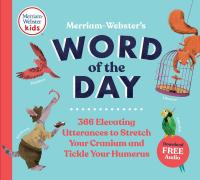
A word (or more) for each day of each month is presented and defined with a pronunciation guide, pleasingly illustrated. At the end of each month, a story is presented that uses all the words, with an audio version (accessed by QR code) so kids can hear it spoken aloud. Clever and appealing!
Merriam-Webster’s Word of the Day: 366 Elevating Utterances to Stretch Your Cranium and Tickle Your Humerus
![Cat Eyes and Dog Whistles: The [Five] Seven Senses of Humans and Other Animals](/sites/default/files/styles/book_cover_mobile_1x/public/book/cat-eyes-and-dog-whistles.jpeg?itok=Ca8obUfm)
Everyone knows their five senses — sight, smell, taste, touch, and hearing — right? But there are two more: proprioception (letting you touch your nose with your finger without seeing either body part) and the vestibular system (in charge of balance). Informal language and lighthearted illustration add a touch of humor in the presentation of solid information, sure to engage.
Cat Eyes and Dog Whistles: The [Five] Seven Senses of Humans and Other Animals
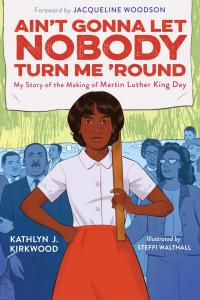
What makes an activist? The assassination of Martin Luther King, Jr. in Tennessee in 1968 so effected young Kathlyn, she started tirelessly working to improve the lives of African Americans and make MLK’s birthday a national holiday. She tells her own story in verse, contextualized by the time in which she lived
